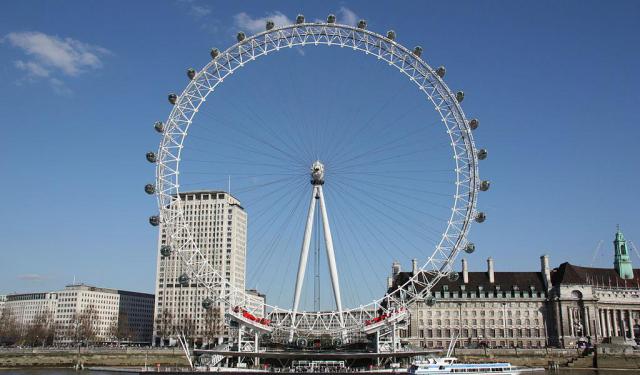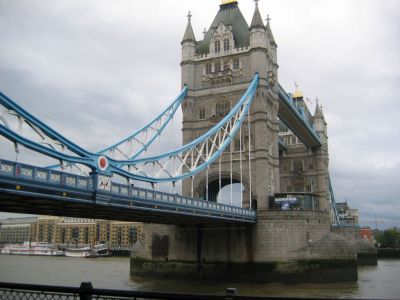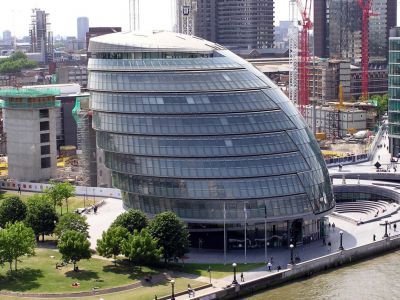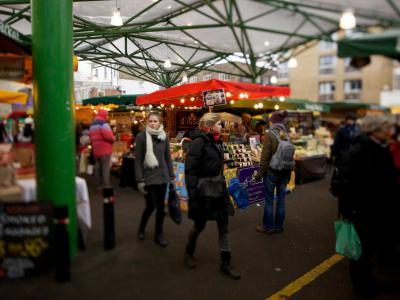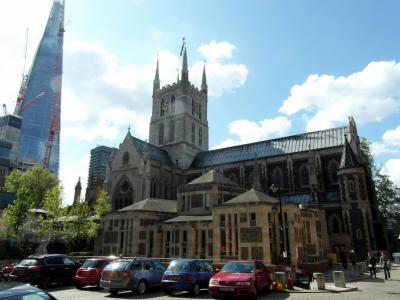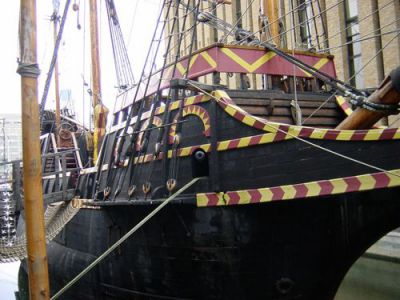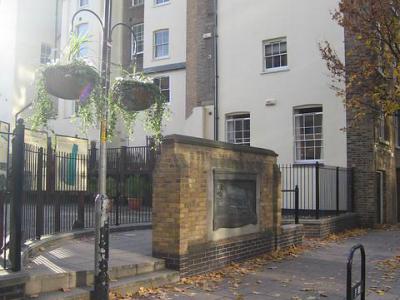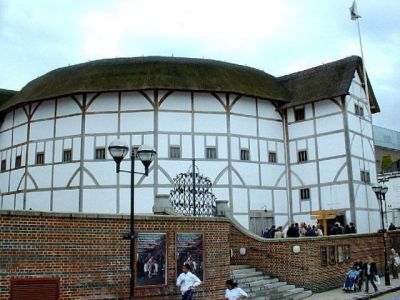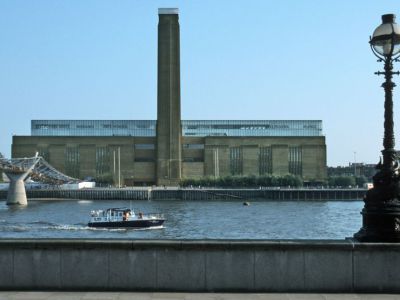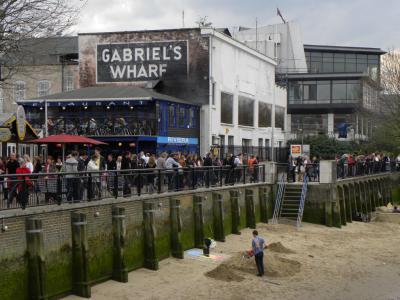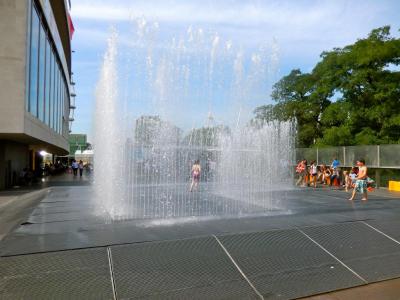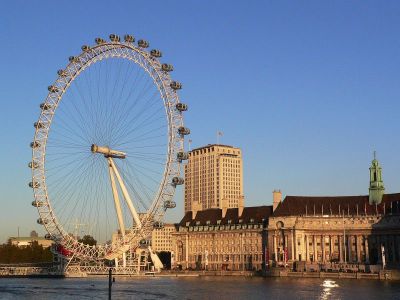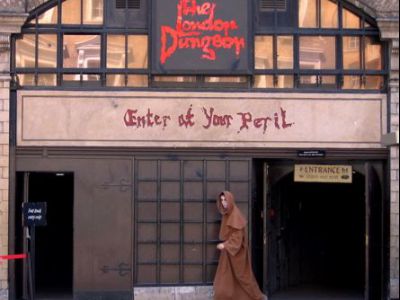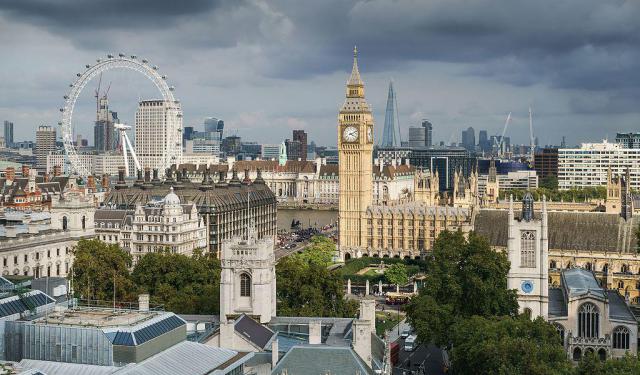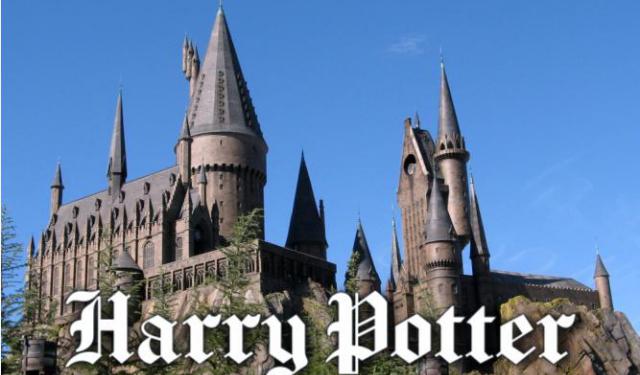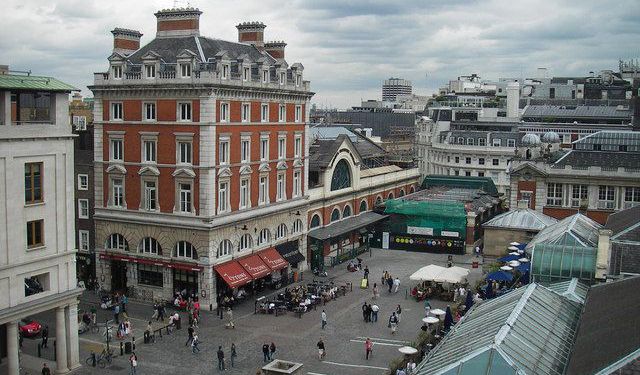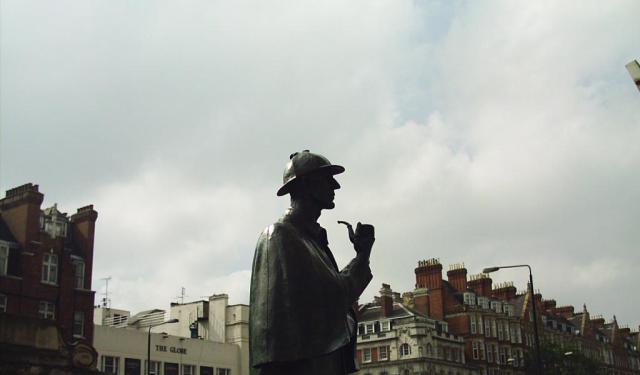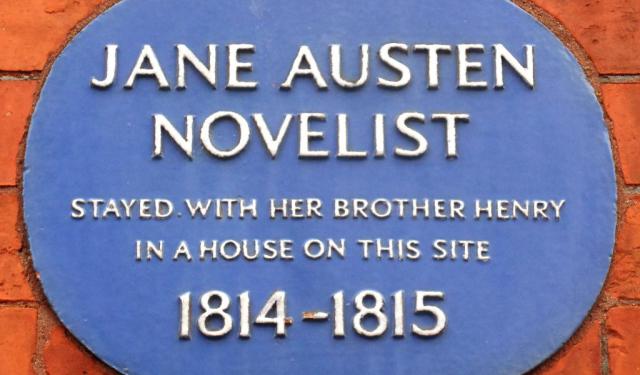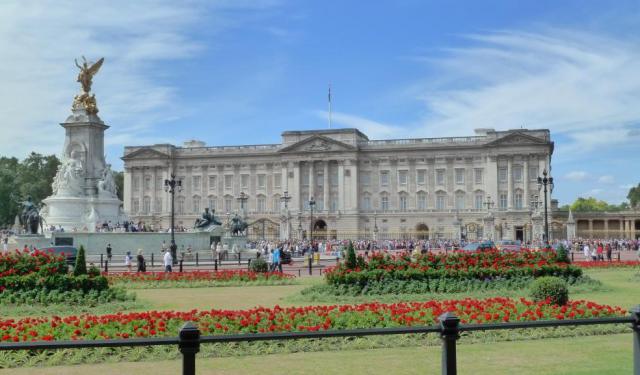Audio Guide: South Bank Walking Tour (Self Guided), London
London’s South Bank, stretching along the southern side of the River Thames, roughly between Westminster Bridge and Tower Bridge, is one of the most interesting and liveliest parts of the British capital. Here, London’s old soul and modern edge shake hands... and then probably go grab a pint together. Famous for its arts, culture, food, and scenic riverside walks, the area has a long and rather rough history.
Originally, the South Bank was outside the formal boundaries of the City of London, meaning it escaped some of the city's stricter rules. In medieval and Tudor times, this was a lively but rowdy place, known for theaters (such as Shakespeare’s Globe), bear-baiting pits, taverns, and less "officially approved" forms of entertainment. Over time, it became more industrial, with docks, warehouses, and working-class housing.
The South Bank we know today really started to take shape after World War II. Much of the area was damaged by bombings, and in 1951, the Festival of Britain was held here to boost national morale and celebrate British creativity and innovation. Key landmarks like the Royal Festival Hall were built for this event, and they remained, helping to turn the South Bank into a major cultural hub.
For tourists, the South Bank is packed with highlights. Starting at Tower Bridge - often mistaken for a medieval relic but actually opened in 1894 - visitors can spot nearby the futuristic glass bubble of City Hall, the new home of London’s mayor. Then, let your nose lead you to Borough Market, which has served Londoners with mouth-watering food for over a thousand years.
After exploring the market, Southwark Cathedral offers a peaceful Gothic retreat, while the Golden Hinde, a full-size replica of Sir Francis Drake’s ship, invites budding adventurers aboard. Shakespeare lovers can visit the original site of the Globe Theatre and experience performances at today’s reconstructed Shakespeare’s Globe.
Keep wandering west and you’ll hit Tate Modern - a repurposed power station turned modern art gallery - and the cozy indie cafés of Gabriel’s Wharf. From there, it’s just a short stroll to the buzzing Southbank Centre, and then up, up, and away on the London Eye, spinning you into panoramic bliss. For those seeking thrills, the London Dungeon nearby plunges into the city’s darker past with actors, special effects, and immersive experiences.
Complete with its historic sights, modern delights, and riverside charm, South Bank delivers an unforgettable slice of London. Anyone wanting to experience the capital’s quirkiest and tastiest sides all in one go, take this self-guided walk.
Originally, the South Bank was outside the formal boundaries of the City of London, meaning it escaped some of the city's stricter rules. In medieval and Tudor times, this was a lively but rowdy place, known for theaters (such as Shakespeare’s Globe), bear-baiting pits, taverns, and less "officially approved" forms of entertainment. Over time, it became more industrial, with docks, warehouses, and working-class housing.
The South Bank we know today really started to take shape after World War II. Much of the area was damaged by bombings, and in 1951, the Festival of Britain was held here to boost national morale and celebrate British creativity and innovation. Key landmarks like the Royal Festival Hall were built for this event, and they remained, helping to turn the South Bank into a major cultural hub.
For tourists, the South Bank is packed with highlights. Starting at Tower Bridge - often mistaken for a medieval relic but actually opened in 1894 - visitors can spot nearby the futuristic glass bubble of City Hall, the new home of London’s mayor. Then, let your nose lead you to Borough Market, which has served Londoners with mouth-watering food for over a thousand years.
After exploring the market, Southwark Cathedral offers a peaceful Gothic retreat, while the Golden Hinde, a full-size replica of Sir Francis Drake’s ship, invites budding adventurers aboard. Shakespeare lovers can visit the original site of the Globe Theatre and experience performances at today’s reconstructed Shakespeare’s Globe.
Keep wandering west and you’ll hit Tate Modern - a repurposed power station turned modern art gallery - and the cozy indie cafés of Gabriel’s Wharf. From there, it’s just a short stroll to the buzzing Southbank Centre, and then up, up, and away on the London Eye, spinning you into panoramic bliss. For those seeking thrills, the London Dungeon nearby plunges into the city’s darker past with actors, special effects, and immersive experiences.
Complete with its historic sights, modern delights, and riverside charm, South Bank delivers an unforgettable slice of London. Anyone wanting to experience the capital’s quirkiest and tastiest sides all in one go, take this self-guided walk.
How it works: Download the app "GPSmyCity: Walks in 1K+ Cities" from Apple App Store or Google Play Store to your mobile phone or tablet. The app turns your mobile device into a personal tour guide and its built-in GPS navigation functions guide you from one tour stop to next. The app works offline, so no data plan is needed when traveling abroad.
South Bank Walking Tour Map
Guide Name: South Bank Walking Tour
Guide Location: England » London (See other walking tours in London)
Guide Type: Self-guided Walking Tour (Sightseeing)
# of Attractions: 12
Tour Duration: 3 Hour(s)
Travel Distance: 4.8 Km or 3 Miles
Author: DanaOffice
Sight(s) Featured in This Guide:
Guide Location: England » London (See other walking tours in London)
Guide Type: Self-guided Walking Tour (Sightseeing)
# of Attractions: 12
Tour Duration: 3 Hour(s)
Travel Distance: 4.8 Km or 3 Miles
Author: DanaOffice
Sight(s) Featured in This Guide:
- Tower Bridge
- City Hall
- Borough Market
- Southwark Cathedral
- Golden Hinde
- Globe Theatre (original site)
- Shakespeare's Globe
- Tate Modern
- Gabriel's Wharf
- Southbank Centre
- London Eye
- London Dungeon
1) Tower Bridge (must see)
Tower Bridge-yes, that famous one with the twin towers and rising roadways-surprisingly didn’t swing into action until 1894. That’s right: it’s younger than your great-great-grandma’s fruitcake recipe, though you'd never guess it based on the number of fridge magnets it’s starred on. Indeed, in just over a century, it’s managed to become one of London’s most iconic symbols-practically the Victorian era in bridge form.
Now here’s a royal twist: Queen Victoria wasn’t exactly thrilled about it at first. She worried the bridge might compromise the security of the nearby Tower of London, which at that time doubled as an armory. Still, they painted it her favorite color-chocolate brown-and forged ahead, perhaps hoping that a well-dressed bridge would soothe Her Majesty’s nerves.
Under the hood (well, under the road), it was all quite steamy-literally. Sophisticated steam-powered engines lifted the bridge’s bascules to allow tall ships to pass through. In its very first year, the bridge went up over 6,000 times-talk about an overachiever! These days, it opens around 1,000 times a year, and somehow, they’ve managed to avoid any major mishaps. If you’re lucky, you might even catch one of those dramatic lifts in real time-free theater, London-style...
For an unforgettable experience, take in the sweeping views of the Thames, the sci-fi egg that is City Hall, the gleaming glass Shard, and the chaos of central London from the top of the bridge. Better yet, grab a ticket and ride the elevator to the elevated walkways. Up there, you’ll find a glass floor for peeking at the world below (great for photos, or mild panic), plus a museum showcasing the original steam engines-because nothing says Victorian romance like big brass machinery. Bonus points: Yes, there are restrooms at the top, so no need to “hold it” at altitude.
And in case you wonder, why you should go?-This masterpiece of Victorian engineering also sparkles at night, and-let’s face it-your trip to London wouldn't be complete without seeing it.
Now here’s a royal twist: Queen Victoria wasn’t exactly thrilled about it at first. She worried the bridge might compromise the security of the nearby Tower of London, which at that time doubled as an armory. Still, they painted it her favorite color-chocolate brown-and forged ahead, perhaps hoping that a well-dressed bridge would soothe Her Majesty’s nerves.
Under the hood (well, under the road), it was all quite steamy-literally. Sophisticated steam-powered engines lifted the bridge’s bascules to allow tall ships to pass through. In its very first year, the bridge went up over 6,000 times-talk about an overachiever! These days, it opens around 1,000 times a year, and somehow, they’ve managed to avoid any major mishaps. If you’re lucky, you might even catch one of those dramatic lifts in real time-free theater, London-style...
For an unforgettable experience, take in the sweeping views of the Thames, the sci-fi egg that is City Hall, the gleaming glass Shard, and the chaos of central London from the top of the bridge. Better yet, grab a ticket and ride the elevator to the elevated walkways. Up there, you’ll find a glass floor for peeking at the world below (great for photos, or mild panic), plus a museum showcasing the original steam engines-because nothing says Victorian romance like big brass machinery. Bonus points: Yes, there are restrooms at the top, so no need to “hold it” at altitude.
And in case you wonder, why you should go?-This masterpiece of Victorian engineering also sparkles at night, and-let’s face it-your trip to London wouldn't be complete without seeing it.
2) City Hall
Sometimes it feels like London’s architects are playing a game: “How can we make visitors feel like they’ve stepped back in time and into the future at the same time?” City Hall is a perfect example of that. Perched by the river, this sci-fi-looking bubble might seem a little odd at first, but give it a minute, and you’ll start to appreciate just how sleek and clever it really is.
Dreamed up by superstar architect Norman Foster and completed in 2002, this 10-story, glass-and-steel structure leans to one side like it’s striking a pose. It’s not just showing off, though - the design is ultra-efficient, taking up far less space than a normal building and using only a quarter of the energy of its more old-school neighbors. Pretty smart for something that looks like it rolled out of a future London skyline.
Fun fact: this was the first time the public got a say in picking the design. And visitors today can still climb the spiral walkway to the second floor to spy on the action below - or just grab a coffee and soak in the atmosphere. As for "London’s Living Room" on the 9th floor, the views from there are absolutely spectacular, but it’s usually off-limits... unless you time your visit for Open House weekend (the third weekend of each month).
Before you wander off, make sure to check out The Scoop - the outdoor amphitheater just next door. From June to September, you can catch free plays, movies, and concerts there under the open sky.
Quick tip: Don't miss Fiona Banner’s shiny black Full Stops sculptures nearby - giant punctuation marks in bronze, making even grammar feel epic...
Dreamed up by superstar architect Norman Foster and completed in 2002, this 10-story, glass-and-steel structure leans to one side like it’s striking a pose. It’s not just showing off, though - the design is ultra-efficient, taking up far less space than a normal building and using only a quarter of the energy of its more old-school neighbors. Pretty smart for something that looks like it rolled out of a future London skyline.
Fun fact: this was the first time the public got a say in picking the design. And visitors today can still climb the spiral walkway to the second floor to spy on the action below - or just grab a coffee and soak in the atmosphere. As for "London’s Living Room" on the 9th floor, the views from there are absolutely spectacular, but it’s usually off-limits... unless you time your visit for Open House weekend (the third weekend of each month).
Before you wander off, make sure to check out The Scoop - the outdoor amphitheater just next door. From June to September, you can catch free plays, movies, and concerts there under the open sky.
Quick tip: Don't miss Fiona Banner’s shiny black Full Stops sculptures nearby - giant punctuation marks in bronze, making even grammar feel epic...
3) Borough Market (must see)
Borough Market is London’s oldest and most atmospheric food market, boasting a history that spans over 1,000 years. Its origins trace back to the 11th century - and possibly earlier - when farmers would bring fresh produce to London Bridge, then the only southern entrance into the city. By the 18th century, the market had become so chaotic that Parliament decided to shut it down in 1756, though local volunteers soon revived it nearby. The structures seen today, with ornate Victorian ironwork and soaring arcades, were developed largely in the 19th century.
Today, with a railway rumbling overhead, this historic market hums below as a vibrant maze of culinary treasures. Visitors can explore an impressive range of artisan stalls offering cheeses, fresh bread, meats, seafood, organic produce, spices, handmade sweets, and gourmet street food. While British classics like meat pies and sausages are readily available, the real appeal lies in the diversity - from Ethiopian stews and Indian curries to Spanish paella and Middle Eastern falafel.
Navigating the market is part of the fun. Begin your adventure through the central labyrinth of food stalls until you reach Stoney Street on the western edge. From there, stroll along Park Street - a film location favorite - where you’ll find a lively pub and the famous Neal’s Yard Dairy cheese shop. Across the way, the Ginger Pig draws crowds for its traditional English bacon and sausages. For a local favorite, stop by Maria’s Market Café, a classic haunt for longtime market workers. Around every corner, more delights await, including covered terraces with extra seating for diners.
Rain or shine, Borough Market delivers. The partial roof makes it an all-weather destination, and beyond eating and shopping, visitors can enjoy food tastings, seasonal festivals, cooking demos, and culinary workshops. The market thrives on community and celebration, drawing food lovers from around the world.
Conveniently located near landmarks like Southwark Cathedral, The Shard, and Shakespeare’s Globe Theatre, it’s a perfect stop during a day exploring London’s South Bank.
Tip:
Before committing to a meal, take your time wandering. Getting a bit lost is part of the charm - and often leads to the tastiest surprises.
Today, with a railway rumbling overhead, this historic market hums below as a vibrant maze of culinary treasures. Visitors can explore an impressive range of artisan stalls offering cheeses, fresh bread, meats, seafood, organic produce, spices, handmade sweets, and gourmet street food. While British classics like meat pies and sausages are readily available, the real appeal lies in the diversity - from Ethiopian stews and Indian curries to Spanish paella and Middle Eastern falafel.
Navigating the market is part of the fun. Begin your adventure through the central labyrinth of food stalls until you reach Stoney Street on the western edge. From there, stroll along Park Street - a film location favorite - where you’ll find a lively pub and the famous Neal’s Yard Dairy cheese shop. Across the way, the Ginger Pig draws crowds for its traditional English bacon and sausages. For a local favorite, stop by Maria’s Market Café, a classic haunt for longtime market workers. Around every corner, more delights await, including covered terraces with extra seating for diners.
Rain or shine, Borough Market delivers. The partial roof makes it an all-weather destination, and beyond eating and shopping, visitors can enjoy food tastings, seasonal festivals, cooking demos, and culinary workshops. The market thrives on community and celebration, drawing food lovers from around the world.
Conveniently located near landmarks like Southwark Cathedral, The Shard, and Shakespeare’s Globe Theatre, it’s a perfect stop during a day exploring London’s South Bank.
Tip:
Before committing to a meal, take your time wandering. Getting a bit lost is part of the charm - and often leads to the tastiest surprises.
4) Southwark Cathedral
Locals call it "Suth-uck," but you can just call it London’s oldest Gothic church-and one of its best-kept secrets. Parts of Southwark Cathedral hail from the 12th century, though you wouldn’t know it from the modest tourist traffic. Inside, you'll stumble across all kinds of treasures, like a late-13th-century wooden knight who’s been lying down on the job for about 700 years.
Southwark started life as a priory, became a palace church for Henry VIII, and was eventually bought by a plucky group of merchants in 1611. With a bit of a Victorian glow-up during the 1800s, it officially got its cathedral badge in 1905 (better late than never). The building took quite a beating during the London Blitz-about 1,600 bombs were dropped on the site-and you can still spot the scars on its outer walls if you look closely.
Now, if you’re in a browsing mood, look up at the colorful 15th-century roof bosses-basically medieval doodles carved in wood-and don’t miss the tomb of poet John Gower. The latter was pals with Geoffrey Chaucer ("father of English literature", best known for The Canterbury Tales) and once served as poet laureate to Richard II. Fancy...
There’s also the Harvard Chapel, marking the baptism spot of John Harvard-yes, that very Harvard-the local lad who went off and founded a university in the U.S. you might have heard of.
Back in Shakespeare’s day, Southwark wasn’t just the place to pray-it was the place to play. Theaters like The Globe, The Rose, and The Swan turned the area into London’s entertainment hotspot. William himself bunked nearby for a while, close enough to hear the cathedral bells, and he used to worship here, too.
Was he a regular churchgoer? Hard to say. Shakespeare’s religious leanings are about as clear as a London fog. But his friends certainly showed up here. Even Shakespeare’s younger brother, Edmund-an actor like his big bro-was buried here in 1607.
Today, the cathedral tips its hat to the Bard with a stunning memorial: a reclining Shakespeare statue, casually lounging beneath a stained glass window sparkling with scenes from his plays. It’s literary London at its finest.
Before you leave, wander through the churchyard, now a lovely herb garden, and follow the charming Millennium Courtyard right down to the river. It’s history, drama, and a breath of fresh air-all tucked just out of sight from the tourist crowds.
Southwark started life as a priory, became a palace church for Henry VIII, and was eventually bought by a plucky group of merchants in 1611. With a bit of a Victorian glow-up during the 1800s, it officially got its cathedral badge in 1905 (better late than never). The building took quite a beating during the London Blitz-about 1,600 bombs were dropped on the site-and you can still spot the scars on its outer walls if you look closely.
Now, if you’re in a browsing mood, look up at the colorful 15th-century roof bosses-basically medieval doodles carved in wood-and don’t miss the tomb of poet John Gower. The latter was pals with Geoffrey Chaucer ("father of English literature", best known for The Canterbury Tales) and once served as poet laureate to Richard II. Fancy...
There’s also the Harvard Chapel, marking the baptism spot of John Harvard-yes, that very Harvard-the local lad who went off and founded a university in the U.S. you might have heard of.
Back in Shakespeare’s day, Southwark wasn’t just the place to pray-it was the place to play. Theaters like The Globe, The Rose, and The Swan turned the area into London’s entertainment hotspot. William himself bunked nearby for a while, close enough to hear the cathedral bells, and he used to worship here, too.
Was he a regular churchgoer? Hard to say. Shakespeare’s religious leanings are about as clear as a London fog. But his friends certainly showed up here. Even Shakespeare’s younger brother, Edmund-an actor like his big bro-was buried here in 1607.
Today, the cathedral tips its hat to the Bard with a stunning memorial: a reclining Shakespeare statue, casually lounging beneath a stained glass window sparkling with scenes from his plays. It’s literary London at its finest.
Before you leave, wander through the churchyard, now a lovely herb garden, and follow the charming Millennium Courtyard right down to the river. It’s history, drama, and a breath of fresh air-all tucked just out of sight from the tourist crowds.
5) Golden Hinde
Ahoy, history buffs and aspiring pirates! From 1577 to 1580, the not-so-charming Sir Francis Drake - a pirate, slave trader, and all-around troublemaker - sailed around the globe aboard this vessel, plundering enough loot to out-earn Queen Elizabeth I herself. Not bad for three years’ work on the high seas...
More recently, in the 1970s, someone thought, “Hey, let’s rebuild that thing!” Thus, the full-sized replica we see today was born. This modern-day Golden Hinde didn’t just sit still - oh no. It clocked over 160,000 kilometers (that’s 100,000 miles, landlubbers), circumnavigating the globe once and then playing floating museum at ports all over the U.S. coastline. Finally, in 1995, it dropped anchor permanently in London.
Nowadays, the ship continues its swashbuckling mission with a lively weekend crew dressed in Tudor garb. Onboard, you’ll find three decks stuffed with historical curiosities and the charming scent of 16th-century discomfort. Cram yourself onto the gundeck - where most of Drake’s 80-strong crew slept, often elbow-to-elbow with sheep and goats - and you’ll wonder how they didn’t mutiny just for legroom.
For the wee ones, there are puppet shows, pirate training camps, and all the Yo-ho-ho their little hearts can handle. Grown-ups, worry not either - sea shanty choirs often drop anchor here, belting out maritime tunes that’ll make you want to hoist a pint and sing along...
More recently, in the 1970s, someone thought, “Hey, let’s rebuild that thing!” Thus, the full-sized replica we see today was born. This modern-day Golden Hinde didn’t just sit still - oh no. It clocked over 160,000 kilometers (that’s 100,000 miles, landlubbers), circumnavigating the globe once and then playing floating museum at ports all over the U.S. coastline. Finally, in 1995, it dropped anchor permanently in London.
Nowadays, the ship continues its swashbuckling mission with a lively weekend crew dressed in Tudor garb. Onboard, you’ll find three decks stuffed with historical curiosities and the charming scent of 16th-century discomfort. Cram yourself onto the gundeck - where most of Drake’s 80-strong crew slept, often elbow-to-elbow with sheep and goats - and you’ll wonder how they didn’t mutiny just for legroom.
For the wee ones, there are puppet shows, pirate training camps, and all the Yo-ho-ho their little hearts can handle. Grown-ups, worry not either - sea shanty choirs often drop anchor here, belting out maritime tunes that’ll make you want to hoist a pint and sing along...
6) Globe Theatre (original site)
If you wander down Park Street today, you’ll find a humble plaque and a few story panels marking the original spot where the Globe Theatre opened its doors in 1599. Back then, this stretch was called Maiden Lane, tucked inside The Liberty of the Clink-basically a medieval no-man’s-land just outside the City’s rules. At one point, the Bishop of Winchester took charge, and instead of banning the local theaters, animal fights, and brothels, he simply taxed them. A solid business model, really.
Shakespeare’s company flourished here, and about 15 of his plays-including some of the biggest hits-first hit the stage on this very ground.
Of course, no great story is complete without a little fire. On June 29, 1613, during a performance of Henry VIII, a prop cannon misfired and set the place ablaze. The Globe, made of good old flammable wood and thatch, went up like a tinderbox. Miraculously, nobody was hurt-except for one poor guy whose flaming trousers were put out with a well-aimed bottle of ale. (Talk about happy hour.)
The Globe was rebuilt the next year, but sadly, by 1644 it was demolished to make way for housing. Fast forward to our days: Shakespeare’s Globe, the modern reconstruction, opened its doors in 1997-with Henry V, naturally-proving that not even a fire, a bishop, or centuries of urban sprawl could keep Shakespeare’s spirit off the stage...
Shakespeare’s company flourished here, and about 15 of his plays-including some of the biggest hits-first hit the stage on this very ground.
Of course, no great story is complete without a little fire. On June 29, 1613, during a performance of Henry VIII, a prop cannon misfired and set the place ablaze. The Globe, made of good old flammable wood and thatch, went up like a tinderbox. Miraculously, nobody was hurt-except for one poor guy whose flaming trousers were put out with a well-aimed bottle of ale. (Talk about happy hour.)
The Globe was rebuilt the next year, but sadly, by 1644 it was demolished to make way for housing. Fast forward to our days: Shakespeare’s Globe, the modern reconstruction, opened its doors in 1997-with Henry V, naturally-proving that not even a fire, a bishop, or centuries of urban sprawl could keep Shakespeare’s spirit off the stage...
7) Shakespeare's Globe (must see)
Welcome to Shakespeare’s Globe-or, as some like to call it, the Bard’s comeback tour, 400 years in the making. This stunning open-air theater is a faithful, full-thatch, no-nails, "mind the splinters" replica of the original Globe Playhouse. The original Globe opened in 1599 but met a rather dramatic end in 1613 when a stage cannon misfired during a performance. Boom! Theater barbecue...
A few centuries on, enter Sam Wanamaker-an American actor and director with a British theater obsession and the patience of a saint. He spent decades rallying support to resurrect the Globe, and by 1997, his dream was finally realized. The new Globe stands just 200 yards from where the original once stood, crafted with the same old-school tools and materials (no concrete shortcuts here). Today, it stages Shakespeare’s hits, deep cuts, and even some gems by his playwright pals.
Now, if you're planning to channel your inner Elizabethan and stand as a "Groundling"-congrats! You'll be closest to the action. But don’t expect a seat or sympathy for your aching feet. Want to sit like a civilized 17th-century noble? Great, there are benches-wooden, backless, and full of historical charm. Pro tip: rent a cushion. Or bring one. Or risk the full Tudor chiropractic experience...
And yes, this is an open-air venue. Come rain or shine, or heatwave, or hail-the show must go on. Umbrellas are a no-go (sorry, your neighbor’s view matters too), but you can grab a stylish Globe poncho, which doubles as a weather shield and souvenir.
The main season runs from April to October. If you prefer candlelit drama without the outdoor breeze, head next door to the Sam Wanamaker Playhouse, a 350-seat Jacobean gem lit entirely by candlelight. It’s cozy, atmospheric, and yes-some benches are still backless. You’ve been warned.
Why visit? – You may ask. Because this is as close as you’ll ever get to actual time travel without a DeLorean (remember that car from the Back to the Future trilogy). So, if you’re a die-hard Shakespeare fan or just in it for the costumes and swordfights, the Globe delivers the drama, the laughs, and the full Renaissance vibes all the same.
Curtain up, ponchos on-see you in Southwark...
Tip:
Join a guided tour before 4 pm (unless a matinee’s on, then get in before noon). Wanamaker tours are rarer, so book those in advance if you're lucky enough to find one.
A few centuries on, enter Sam Wanamaker-an American actor and director with a British theater obsession and the patience of a saint. He spent decades rallying support to resurrect the Globe, and by 1997, his dream was finally realized. The new Globe stands just 200 yards from where the original once stood, crafted with the same old-school tools and materials (no concrete shortcuts here). Today, it stages Shakespeare’s hits, deep cuts, and even some gems by his playwright pals.
Now, if you're planning to channel your inner Elizabethan and stand as a "Groundling"-congrats! You'll be closest to the action. But don’t expect a seat or sympathy for your aching feet. Want to sit like a civilized 17th-century noble? Great, there are benches-wooden, backless, and full of historical charm. Pro tip: rent a cushion. Or bring one. Or risk the full Tudor chiropractic experience...
And yes, this is an open-air venue. Come rain or shine, or heatwave, or hail-the show must go on. Umbrellas are a no-go (sorry, your neighbor’s view matters too), but you can grab a stylish Globe poncho, which doubles as a weather shield and souvenir.
The main season runs from April to October. If you prefer candlelit drama without the outdoor breeze, head next door to the Sam Wanamaker Playhouse, a 350-seat Jacobean gem lit entirely by candlelight. It’s cozy, atmospheric, and yes-some benches are still backless. You’ve been warned.
Why visit? – You may ask. Because this is as close as you’ll ever get to actual time travel without a DeLorean (remember that car from the Back to the Future trilogy). So, if you’re a die-hard Shakespeare fan or just in it for the costumes and swordfights, the Globe delivers the drama, the laughs, and the full Renaissance vibes all the same.
Curtain up, ponchos on-see you in Southwark...
Tip:
Join a guided tour before 4 pm (unless a matinee’s on, then get in before noon). Wanamaker tours are rarer, so book those in advance if you're lucky enough to find one.
8) Tate Modern (must see)
Once upon a smokestack, this mid-20th-century power station went from fueling machines to fueling imaginations - and today, this is one of the most-visited modern art museums on the planet: the Tate Modern.
Inside, the art doesn’t march along a tidy timeline. Instead, it sprawls across eight thematically curated zones, mixing heavy-hitters like Matisse with up-to-the-minute works by contemporary rebels. The temporary exhibitions here also feature big names and bold ideas. Think Gauguin, Modigliani, Picasso, O’Keeffe… and entire showcases exploring Soviet art between the Revolution and Stalin’s iron curtain call.
Step into the Turbine Hall - Tate’s dramatic entrance that could probably house a small airport - and you’ll be greeted by gravity-defying installations like Olafur Eliasson’s indoor sun, Ai Weiwei’s sea of porcelain sunflower seeds, or Carsten Höller’s towering steel slides that turn art appreciation into a full-body experience.
Dive underground and you’ll hit The Tanks: not for oil anymore, but for experimental art. We're talking performance pieces, soundscapes, and moving images that make your brain do backflips. Climb skyward to the rooftop terrace for a killer panoramic view of London’s skyline (and if you’re lucky, some weather to match).
In between, there are three expansive exhibition levels featuring everything from global contemporary art to interactive displays and full-room installations. Level 2 is home to the Start Display, where color takes center stage in a global conversation between cultures and eras.
Tip:
If your feet get tired or your brain starts spinning, grab a seat and a snack. There’s a restaurant with skyline views on Level 9, a relaxed café on Level 1, and a cozy espresso bar on Level 3. Don’t miss the balcony on Level 3 either - the view of St. Paul’s from there is pure poetry. Oh, and don’t leave without trying the Tate Draw. Sketch, swipe, and project your masterpiece onto the wall like the digital da Vinci you are.
Inside, the art doesn’t march along a tidy timeline. Instead, it sprawls across eight thematically curated zones, mixing heavy-hitters like Matisse with up-to-the-minute works by contemporary rebels. The temporary exhibitions here also feature big names and bold ideas. Think Gauguin, Modigliani, Picasso, O’Keeffe… and entire showcases exploring Soviet art between the Revolution and Stalin’s iron curtain call.
Step into the Turbine Hall - Tate’s dramatic entrance that could probably house a small airport - and you’ll be greeted by gravity-defying installations like Olafur Eliasson’s indoor sun, Ai Weiwei’s sea of porcelain sunflower seeds, or Carsten Höller’s towering steel slides that turn art appreciation into a full-body experience.
Dive underground and you’ll hit The Tanks: not for oil anymore, but for experimental art. We're talking performance pieces, soundscapes, and moving images that make your brain do backflips. Climb skyward to the rooftop terrace for a killer panoramic view of London’s skyline (and if you’re lucky, some weather to match).
In between, there are three expansive exhibition levels featuring everything from global contemporary art to interactive displays and full-room installations. Level 2 is home to the Start Display, where color takes center stage in a global conversation between cultures and eras.
Tip:
If your feet get tired or your brain starts spinning, grab a seat and a snack. There’s a restaurant with skyline views on Level 9, a relaxed café on Level 1, and a cozy espresso bar on Level 3. Don’t miss the balcony on Level 3 either - the view of St. Paul’s from there is pure poetry. Oh, and don’t leave without trying the Tate Draw. Sketch, swipe, and project your masterpiece onto the wall like the digital da Vinci you are.
9) Gabriel's Wharf
Once just an empty patch by the Thames, Gabriel’s Wharf has pulled off the ultimate glow-up. Today, it’s a lively riverside hotspot where you can shop, eat, sip coffee, and soak in stunning views - all without leaving London’s South Bank. Proof (if you ever needed it) that a neglected waterfront can turn into pure gold for local businesses, artists, and hungry wanderers.
Gabriel’s Wharf serves up a mix of the unexpected: designer boutiques, quirky art galleries, fair-trade shops, and more cafés, bars, and restaurants than your stomach can probably handle in one visit. Every storefront has its own vibe - literally, because local artists helped design them. It's like a pop-up village where no two corners look the same.
Fun fact: Gabriel’s Wharf isn’t just any market - it holds the proud title of London’s oldest pop-up spot. And here’s the kicker: the whole place was built in just three months, on a shoestring budget of £78,000. Take that, overpriced city developers...
Locals like to call it a waterfront town square, and honestly, they're not wrong. It’s the kind of place where you can find a hand-painted scarf, a sculpture of a penguin wearing sunglasses, and the best fish and chips of your life - all before lunch.
Gabriel’s Wharf serves up a mix of the unexpected: designer boutiques, quirky art galleries, fair-trade shops, and more cafés, bars, and restaurants than your stomach can probably handle in one visit. Every storefront has its own vibe - literally, because local artists helped design them. It's like a pop-up village where no two corners look the same.
Fun fact: Gabriel’s Wharf isn’t just any market - it holds the proud title of London’s oldest pop-up spot. And here’s the kicker: the whole place was built in just three months, on a shoestring budget of £78,000. Take that, overpriced city developers...
Locals like to call it a waterfront town square, and honestly, they're not wrong. It’s the kind of place where you can find a hand-painted scarf, a sculpture of a penguin wearing sunglasses, and the best fish and chips of your life - all before lunch.
10) Southbank Centre
If London’s South Bank is a party, then the Southbank Centre is definitely one of the hosts - and it knows how to throw a good one. Sitting proudly alongside heavyweights like the National Theatre and the British Film Institute, the Southbank Centre is a powerhouse of arts, culture, and general creative buzz.
This sprawling concrete wonderland bundles together four big venues: the Royal Festival Hall, the Hayward Gallery, the Queen Elizabeth Hall, and the Purcell Room. And rest assured, it’s never just sitting quietly - the place hums with life, from rooftop bars and riverside cafes to open terraces where the soundtrack is anything from a violin solo to a spontaneous drum circle.
What’s on the menu? Pretty much everything. You can catch classical concerts, opera, folk, world music, avant-garde experiments that will make your head spin - and just when you think you've figured it out, here come comedy shows, thought-provoking talks, dance performances, and a whole parade of festivals. Ever heard of the London Jazz Festival, Women of the World (or WOW) Festival, London Literature Festival, or Meltdown? Yep, all that and more happen right here.
And in case you wonder, why should you pop in? Because where else can you stroll the river, grab a drink, see an art exhibition, listen to a world-class concert, and maybe accidentally join a flash mob - all before dinner? With a top-tier gallery and three world-class auditoriums stitched into the riverside fabric, the Southbank Centre isn’t just a cultural landmark - it’s a full-blown experience.
This sprawling concrete wonderland bundles together four big venues: the Royal Festival Hall, the Hayward Gallery, the Queen Elizabeth Hall, and the Purcell Room. And rest assured, it’s never just sitting quietly - the place hums with life, from rooftop bars and riverside cafes to open terraces where the soundtrack is anything from a violin solo to a spontaneous drum circle.
What’s on the menu? Pretty much everything. You can catch classical concerts, opera, folk, world music, avant-garde experiments that will make your head spin - and just when you think you've figured it out, here come comedy shows, thought-provoking talks, dance performances, and a whole parade of festivals. Ever heard of the London Jazz Festival, Women of the World (or WOW) Festival, London Literature Festival, or Meltdown? Yep, all that and more happen right here.
And in case you wonder, why should you pop in? Because where else can you stroll the river, grab a drink, see an art exhibition, listen to a world-class concert, and maybe accidentally join a flash mob - all before dinner? With a top-tier gallery and three world-class auditoriums stitched into the riverside fabric, the Southbank Centre isn’t just a cultural landmark - it’s a full-blown experience.
11) London Eye (must see)
Say hello to the London Eye - or, if you’re feeling fancy, the Millennium Wheel. Built to welcome the year 2000 in style, it had its soft launch in late 1999 and officially opened in March 2000. Designed by architects David Marks and Julia Barfield, it was supposed to be temporary... but Londoners loved it so much, they basically said, “Nope, it’s staying.”
At 135 meters (that’s 443 feet if you’re still thinking imperial), the Eye was once the tallest observation wheel on the planet - and it still holds the crown in Europe. The ride - a slow, elegant spin takes about 30 minutes, offering jaw-dropping, 360-degree views stretching up to 40 kilometers on a clear day. From Big Ben to Buckingham Palace - and if you squint, even Windsor Castle - London is laid out before you like a pop-up storybook.
Each of the 32 sleek glass capsules (one for each London borough) can carry up to 28 people. Great for selfies, great for proposals, and perfect if you just want to stare out and feel dramatically reflective.
Want to dial up the experience? Your ticket comes with a 4D cinema show, or you can upgrade to private pods or champagne flights if you're feeling extra. Plus, the Eye sits right on the South Bank - a hop away from the SEA LIFE Aquarium, the London Dungeon, and the laid-back Jubilee Gardens.
Fun fact: The Eye’s giant bicycle-wheel design is a true European team effort - with British steel, Dutch engineering, and a smattering of German, French, Czech, and Italian parts.
Bottom line: Whether you're new in town or just want to fall in love with London all over again, the London Eye is a must-spin.
Tip:
Book online to save cash and skip the long lines. Your Instagram will thank you.
At 135 meters (that’s 443 feet if you’re still thinking imperial), the Eye was once the tallest observation wheel on the planet - and it still holds the crown in Europe. The ride - a slow, elegant spin takes about 30 minutes, offering jaw-dropping, 360-degree views stretching up to 40 kilometers on a clear day. From Big Ben to Buckingham Palace - and if you squint, even Windsor Castle - London is laid out before you like a pop-up storybook.
Each of the 32 sleek glass capsules (one for each London borough) can carry up to 28 people. Great for selfies, great for proposals, and perfect if you just want to stare out and feel dramatically reflective.
Want to dial up the experience? Your ticket comes with a 4D cinema show, or you can upgrade to private pods or champagne flights if you're feeling extra. Plus, the Eye sits right on the South Bank - a hop away from the SEA LIFE Aquarium, the London Dungeon, and the laid-back Jubilee Gardens.
Fun fact: The Eye’s giant bicycle-wheel design is a true European team effort - with British steel, Dutch engineering, and a smattering of German, French, Czech, and Italian parts.
Bottom line: Whether you're new in town or just want to fall in love with London all over again, the London Eye is a must-spin.
Tip:
Book online to save cash and skip the long lines. Your Instagram will thank you.
12) London Dungeon
The London Dungeon is a darkly theatrical tourist attraction that plunges visitors into 1,000 years of gruesome and grisly London history. What began in 1974 as a waxwork exhibit beneath London Bridge station has since evolved into a high-energy immersive experience. After a major £20 million redevelopment in 2013, the attraction moved to County Hall on the South Bank, right beside the London Eye. This relocation brought upgraded sets, new live shows, and easier access for tourists exploring the riverside.
The 90-minute experience blends storytelling, scare tactics, and dark humor. Costumed actors guide audiences through scenes featuring real and legendary figures, from Boudica (the queen of the ancient British tribe, who led a failed uprising against the conquering forces of the Roman Empire in the 1st century AD) to Jack the Ripper. Visitors walk through detailed sets recreating the Black Death, the Great Fire of London, Henry VIII’s brutal reign, and even the infamous barber Sweeney Todd. Guests don’t just watch - they become part of the show. You might be “put on trial,” stumble through plague-ridden streets, or be threatened by a shadowy figure in the dark.
A standout feature is the "Drop Dead: Drop Ride," a free-fall ride simulating a public hanging - not for the faint-hearted. The attraction’s soundscape is purposefully unsettling, with screams and eerie music underscoring the entire journey.
However, the Dungeon isn’t just about scares - it leans into its own over-the-top style with tongue-in-cheek narration, making it as amusing as it is macabre. Special events, especially around Halloween, intensify the thrills. In 2024, the Dungeon celebrated its 50th anniversary with a séance-themed show, adding an extra layer of supernatural suspense.
Though children often flock to the attraction, it’s not for everyone. Some scenes can be genuinely disturbing, especially for sensitive guests, adults included. During weekends and school holidays, long lines are common, though evening adult-only tours, which include drinks, offer a more exclusive (and possibly even darker) alternative.
The Dungeon is open daily, generally from 11:00 AM to 4:00 PM, with extended hours on busy days. Tickets start at over £25, but online bookings can save up to 30%. Bundle deals with nearby attractions like SEA LIFE London and the London Eye can offer even bigger discounts.
For anyone fascinated by London’s bloody, bizarre, and often tragic past, the London Dungeon delivers history with a jolt of adrenaline.
The 90-minute experience blends storytelling, scare tactics, and dark humor. Costumed actors guide audiences through scenes featuring real and legendary figures, from Boudica (the queen of the ancient British tribe, who led a failed uprising against the conquering forces of the Roman Empire in the 1st century AD) to Jack the Ripper. Visitors walk through detailed sets recreating the Black Death, the Great Fire of London, Henry VIII’s brutal reign, and even the infamous barber Sweeney Todd. Guests don’t just watch - they become part of the show. You might be “put on trial,” stumble through plague-ridden streets, or be threatened by a shadowy figure in the dark.
A standout feature is the "Drop Dead: Drop Ride," a free-fall ride simulating a public hanging - not for the faint-hearted. The attraction’s soundscape is purposefully unsettling, with screams and eerie music underscoring the entire journey.
However, the Dungeon isn’t just about scares - it leans into its own over-the-top style with tongue-in-cheek narration, making it as amusing as it is macabre. Special events, especially around Halloween, intensify the thrills. In 2024, the Dungeon celebrated its 50th anniversary with a séance-themed show, adding an extra layer of supernatural suspense.
Though children often flock to the attraction, it’s not for everyone. Some scenes can be genuinely disturbing, especially for sensitive guests, adults included. During weekends and school holidays, long lines are common, though evening adult-only tours, which include drinks, offer a more exclusive (and possibly even darker) alternative.
The Dungeon is open daily, generally from 11:00 AM to 4:00 PM, with extended hours on busy days. Tickets start at over £25, but online bookings can save up to 30%. Bundle deals with nearby attractions like SEA LIFE London and the London Eye can offer even bigger discounts.
For anyone fascinated by London’s bloody, bizarre, and often tragic past, the London Dungeon delivers history with a jolt of adrenaline.
Walking Tours in London, England
Create Your Own Walk in London
Creating your own self-guided walk in London is easy and fun. Choose the city attractions that you want to see and a walk route map will be created just for you. You can even set your hotel as the start point of the walk.
London Introduction Walking Tour
London: the capital of England, heart of the UK, and international heavyweight in history, culture, and sheer charm. Its name comes straight out of Rome. Londinium was founded circa 43 AD as a trading post. Then came Queen Boudica in 61 AD, who, let’s say, didn’t care much for Roman urban planning and burnt it to the ground. But Londinium wasn’t one to stay down-it bounced back, flourished,... view more
Tour Duration: 2 Hour(s)
Travel Distance: 4.2 Km or 2.6 Miles
Tour Duration: 2 Hour(s)
Travel Distance: 4.2 Km or 2.6 Miles
Harry Potter Walking Tour II
The Harry Potter movies and London go together like Butterbeer and a cold winter night at Hogsmeade. While much of the magical world was brought to life with computer-generated images and studio sets, quite a few iconic scenes were filmed right in the heart of the British capital, transforming ordinary city spots into wizarding landmarks. Here's a look at six more London locations where the... view more
Tour Duration: 2 Hour(s)
Travel Distance: 4.1 Km or 2.5 Miles
Tour Duration: 2 Hour(s)
Travel Distance: 4.1 Km or 2.5 Miles
Covent Garden Walking Tour
A shopping and entertainment hub on the eastern fringes of London's West End, Covent Garden is a district historically associated with the former fruit-and-vegetable market – currently a shopping spot popular with locals and tourists alike.
Once a slum area, today the north of the district is given over to independent shops centered on Neal's Yard and Seven Dials. Both places offer... view more
Tour Duration: 2 Hour(s)
Travel Distance: 3.0 Km or 1.9 Miles
Once a slum area, today the north of the district is given over to independent shops centered on Neal's Yard and Seven Dials. Both places offer... view more
Tour Duration: 2 Hour(s)
Travel Distance: 3.0 Km or 1.9 Miles
Sherlock Holmes Tour in London
Among a myriad of other, real-life celebrities who have ever called London their home, perhaps the most famous is the fictional consulting detective, Sherlock Holmes, created by Conan Doyle. Indeed, the ingenious sleuth has left an indelible mark on the literary and cultural landscape of London ever since the appearance of the first stories about him in the late 1880s. Years on, there are several... view more
Tour Duration: 1 Hour(s)
Travel Distance: 2.3 Km or 1.4 Miles
Tour Duration: 1 Hour(s)
Travel Distance: 2.3 Km or 1.4 Miles
Jane Austen’s London
The celebrated English novelist Jane Austen primarily lived between Bath and Hampshire. However, London also held a special significance in Austen's life. Many of her novels drew inspiration from the capital, like Lydia Bennet and Mr Wickham’s elopement in “Pride & Prejudice.”
One of Austen's cherished spots in London was Twinings, a renowned tea shop. Jane Austen was known... view more
Tour Duration: 2 Hour(s)
Travel Distance: 4.4 Km or 2.7 Miles
One of Austen's cherished spots in London was Twinings, a renowned tea shop. Jane Austen was known... view more
Tour Duration: 2 Hour(s)
Travel Distance: 4.4 Km or 2.7 Miles
Walk around Buckingham Palace
Buckingham Palace, the British monarch's official residence, is a must-see for anyone visiting London, but so are the adjacent royal establishments that give a unique window into the royal way of life. On this self-guided walking tour, along with Buckingham Palace and its memorable fountain, you will visit the St. James's private royal residence, the wonderful Queen's Gallery, and... view more
Tour Duration: 1 Hour(s)
Travel Distance: 2.3 Km or 1.4 Miles
Tour Duration: 1 Hour(s)
Travel Distance: 2.3 Km or 1.4 Miles
Useful Travel Guides for Planning Your Trip
London Souvenirs: 18 Distinctively British Products for Travelers
Most visitors to London consider shopping as part of their must-do London experience. From street markets to Victorian arcades to snobbish Sloane Square to busy Oxford Street, there are a host of shops selling items which typically represent this vibrant city. Whether you are shopping for souvenirs...
The Most Popular Cities
/ view all
